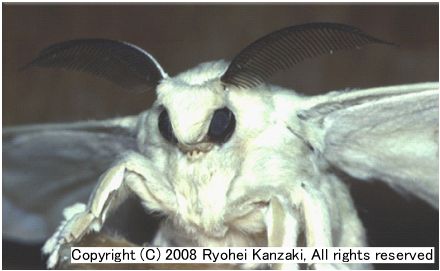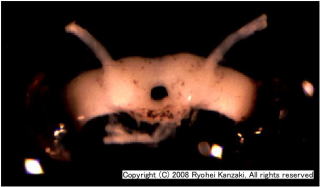


The
domesticated silkmoth (Bombyx
mori L.) belongs to
the butterflies and moths (Insecta: Lepidoptera: Bombycidae). Its
larva is known as silkworm and feeds on the leaves of the mulberry
tree (Morus).
Silk is produced from the cocoon of the pupa. There are various
moth species belonging to different families that can in principle
be used for silk production. The wild ancestor of the domesticated
silkmoth is thought to be the wild silkmoth (Bombyx
mandarina Moore).
The silkmoth is an excellent model system for investigating the
relation between the nervous system and behaviour. In Japan, the
silkmoth is a National
Bioresource. The first sex pheromone whose chemical structure
was identified is bombykol, one of the two components of the
pheromone blend emitted by female B.
mori.
The
silkmoth is an important system for (1) brain science, (2)
commercial use of natural products, and (3) education.
■ Education
・ Lectures & courses (brain/behaviour)
・ EMG amplifier (pdf, Japanese)
・ SPP teaching faculty workshop (Japanese)
Silkmoth(Bombyx mori)
■ Silkmoth behaviour
・Pheromones
■ Nervous system structure and function
・Structure
of insect neurons
・Methods
for investigating neurons
■ Brain function
・ Structure of the silkmoth brain
Protocerebrum■ Odorant receptor mechanisms
・ Odorant receptors (J)
・ General odour receptors (J)
・ Pheromone receptors (J)
■ Pheromone-processing neural pathways
・ Pheromone-processing circuitry (J)
■ Mechanisms of odorant identification
・ Overview (J)
・ Odour discrimination in neural circuits (J)
・ Modeling odour discrimination (J)
■ Neural mechanisms of odour source localisation
・ Odour-source localisation behaviour (J)
・ Neural mechanisms (LAL-VPC) (J)
・ Model of neural mechanisms in LAL-VPC (J)
■ Robotics and insects
・ Insect-robot fusion system: roadmap
・ Robot controlled by a brain model
・ Silkmoth-steered robot
・ Robot control through silkmoth brain activity



■ Brain science
・ Next-generation supercomputer brain simulation (J)
・ Advanced methods to control behaviour (J)
・ Repair of neural circuits (J)
■ Other material
・ Glossary (J)
・ References (J)
・ Reference Book (Japanese)
・ National Bioresouce: silkworm (Japanese)
・ Silkmoth links (J)